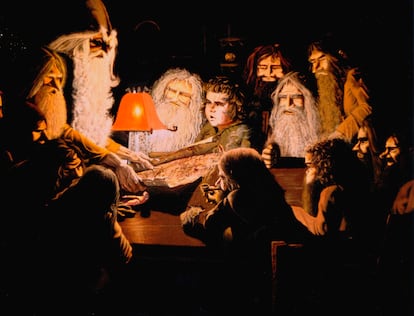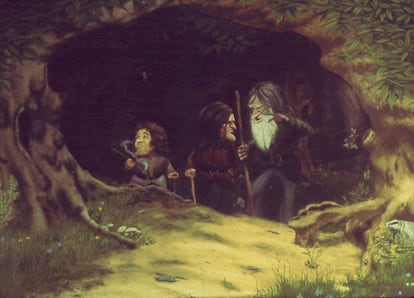A talk with Ted Nasmith, the illustrator who shaped Tolkien’s fantasy universe
One of the most famous creators associated with the author of ‘The Lord of the Rings’ reflects on the eternity of the great fantasy epic and its links with classical art

The rain is drumming on the roof of the indoor bar of the Palacio de Avilés hotel, in northern Spain. It is summer 2024 and the greenery of the building’s sheltered French gardens, visible from here, almost evokes those of the Shire, the most peaceful region of Middle Earth, where the hobbits invented by J. R. R. Tolkien spent their days with no bigger events in their lives than enjoying the smoke rings blown by their long pipes and feasting on the crispy bacon of their second breakfast. Ted Nasmith, 68, is certainly not a hobbit. But the Canadian artist does have the appearance of a wise and serene academic, someone similar to the figure that comes to mind when thinking of Tolkien, the author of The Lord of the Rings, The Hobbit and The Silmarillion, among other fundamental titles of fantasy literature, to whom this classically trained painter has dedicated the best of his successful career.
Nasmith was the star of the 13th Celsius 232 Festival, the biggest fantasy festival in Spain, which owes its name to the conversion of the temperature scale with which Ray Bradbury titled his famous novel Fahrenheit 451. The artist has illustrated dozens of scenes, very much in the biblical style of the classics, of those wonderful people and places invented by Tolkien. Those that illustrate this article were chosen by him; especially the one that portrays Lúthien, an elf whose hair grew like Rapunzel’s, who experiences an extraordinary Romeo and Juliet-like love story with Beren, a human, in one of the most unforgettable stories in The Silmarillion, and one that is still largely unknown to the general public because this collection of stories has not been adapted for the big screen.

Another one, titled Through the Forest, was the first time that Nasmith dared to illustrate Tolkien. It was the initial attempt to reflect that lightning bolt that crossed his soul in December 1971, when he first read the author’s work in an edition of The Hobbit given to him by his sister. “It was a school project, when I was 14 or 15. My teacher asked me to define the task for the whole class. I saw the opportunity. I said that the theme would be the journey and I attempted my first illustration of Tolkien, a group of dwarves emerging from the depths of a forest,” he recalls. That illustration, which accompanies this article, today hangs on the walls of one of Nasmith’s brothers.
Love cannot be faked. The kind of love that emanates from Nasmith’s reverent whispers when he speaks of Tolkien conveys the kind of love, intoxicating and pure, that is only reserved for what one takes to the grave: “Remember he wrote it after the war [Tolkien was a combatant in World War II, along with his two sons]. I know he suffered from depression, because of the terrible things he witnessed. But instead of making his work sour, or turning him into an anti-war activist, the feeling of what he saw was integrated into Middle Earth. Everything takes on a weight, a feeling of death… The glorious days are already past; and it is time to tell, in a way, the end of all things.” He is obviously referring to Tolkien’s monumental masterpiece, The Lord of the Rings, one of the 10 best-selling books of all time, according to multiple classifications.
In terms of his own art, Nasmith sees himself very close to the classical spirit of the great Renaissance masters. Curiously, painting fantastical imagery has brought him closer to the classics. “Artists of the past were very limited in what they could depict. Because, basically, they were biblical scenes paid for by the Church. But suddenly we have a generation of artists, as good as those of the past and with a very similar training, tremendously free to choose the subject matter. I find it especially wonderful that this beautiful and classic art has flourished precisely in the realm of the imaginary,” he notes. The holy trinity of Tolkien artists — John Howe, Alan Lee and himself — have worked in this type of large-format art, indebted to classics such as Michelangelo.

Nasmith has not only dedicated his art to Tolkien. He has also illustrated, with tremendous success, the other great writer of epic fantasy from the second half of the 20th century: George R. R. Martin and his A Song of Ice and Fire or, as it is known by its popular television incarnation, Game of Thrones. But gravity keeps pulling him back to Tolkien and especially to the unfinished collection of fables and mythological scraps that is The Silmarillion, the work that inspired the Amazon-produced television series The Rings of Power. “I want to do something large-format [a coffee table book, the kind of enormous, landscape-sized volume that is the style for showing off illustrated luxury works], something that could even expand a huge, horizontal illustration onto two pages. That is what I want to explore at this stage of my career. As horizontal as possible. And I want to dedicate it to The Silmarillion. I have dozens of sketches that I haven’t turned into paintings yet.”
Is he afraid of repeating himself? Nasmith shares a reflection on what he believes art and life are, the dance between the two extremes: “I think art should be about consistency, not thinking too highly about what you do, but doing it in a way that is totally consistent and coherent as a whole, as if all life and all art were a succession of moments that lead to the same path.” He believes Tolkien’s work is that kind of art. He adds: “I think it was a book for introverts. You can’t be a sociable, party-going egomaniac and appreciate the subtle romance and latent sadness that permeates this work.”
Sign up for our weekly newsletter to get more English-language news coverage from EL PAÍS USA Edition
Tu suscripción se está usando en otro dispositivo
¿Quieres añadir otro usuario a tu suscripción?
Si continúas leyendo en este dispositivo, no se podrá leer en el otro.
FlechaTu suscripción se está usando en otro dispositivo y solo puedes acceder a EL PAÍS desde un dispositivo a la vez.
Si quieres compartir tu cuenta, cambia tu suscripción a la modalidad Premium, así podrás añadir otro usuario. Cada uno accederá con su propia cuenta de email, lo que os permitirá personalizar vuestra experiencia en EL PAÍS.
¿Tienes una suscripción de empresa? Accede aquí para contratar más cuentas.
En el caso de no saber quién está usando tu cuenta, te recomendamos cambiar tu contraseña aquí.
Si decides continuar compartiendo tu cuenta, este mensaje se mostrará en tu dispositivo y en el de la otra persona que está usando tu cuenta de forma indefinida, afectando a tu experiencia de lectura. Puedes consultar aquí los términos y condiciones de la suscripción digital.
More information
Archived In
Últimas noticias
Most viewed
- Reinhard Genzel, Nobel laureate in physics: ‘One-minute videos will never give you the truth’
- Oona Chaplin: ‘I told James Cameron that I was living in a treehouse and starting a permaculture project with a friend’
- Pablo Escobar’s hippos: A serious environmental problem, 40 years on
- Chevy Chase, the beloved comedian who was a monster off camera: ‘Not everyone hated him, just the people who’ve worked with him’
- Why we lost the habit of sleeping in two segments and how that changed our sense of time










































